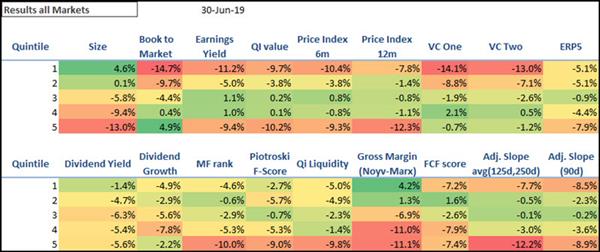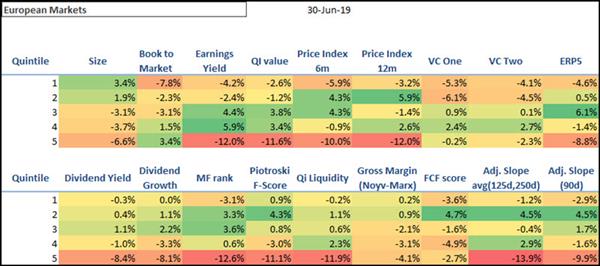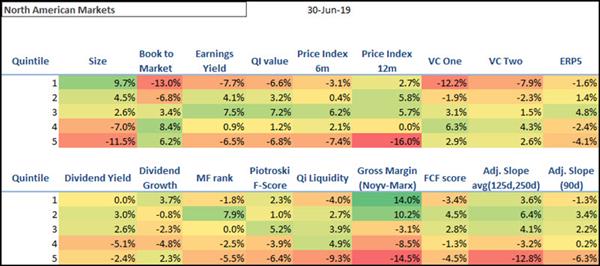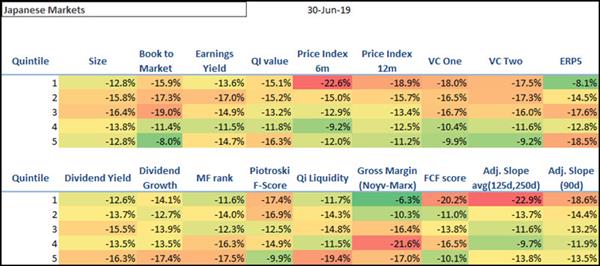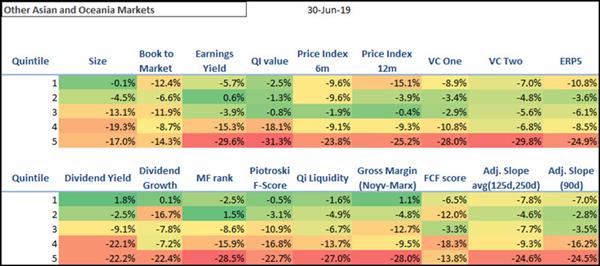If you look at the half year 2019 returns of the 19 investment strategies we tracked you can only come to one conclusion - the markets are messed up!
The returns in 2018 were just as messed up!
With messed up I mean if you look at the performance of nearly all strategies world-wide you will see what has worked in the past (over decades in up and down markets) just did not work in the first half of 2019.
Most strategies recorded losses but in a lot of cases if you invested in undervalued companies your losses would have been greater than if you bought expensive bad quality companies.
What investment strategy worked in the first half of 2019?
So what worked best world-wide in the first half of 2019?
Here is a short summary:
- Buying companies with the highest price to book value (overvalued) would have given you the best return of +4.9%
- Large companies performed well up 4.6% - investing in small companies was a disaster losing 13.0%
- Quality companies selected using the Gross Margin (Novy-Marx) ratio would have given you a decent return of 4.2%
- A high dividend yield investment strategy had relatively low losses of -1.4%
Results were ALL over the place
If you look at the Results all Markets table below you will see that how the rest of the strategies performed.
Performance was all over the place – meaning it was impossible to say what strategy would have done well based on long-term back tested returns of strategies that work.
Before I show you the exact strategies and their returns first some information on what and how we calculated the returns.
What strategies we tested – on 9,000 companies worldwide
We looked at the performance of the following 19 investment strategies from 1 January 2019 to 30 June 2019:
- Large vs small companies (Quintile 1 = Biggest companies)
- Book to Market value (inverse of price to book)
- Earnings yield (EBIT / EV)
- Qi Value ranking – the strategy I use in my own portfolio
- Price Index 6m (Current price / Price 6 months ago) also known as 6 months Momentum
- Price Index 12m (Current price / Price 12 months ago) also known as 12 months momentum
- VC One also known as Value Composite One rank
- VC Two known as Value Composite Two rank (Value Composite One with an additional ratio: Shareholder Yield)
- ERP5 ranking (Ranking based on Price to Book, Earnings Yield, Return on invested capital (ROIC), 5 year average ROIC)
- Shareholders Yield (Dividend yield + Percentage of Shares Repurchased)
- Dividend Yield
- Dividend growth 5 years (The geometric average dividend per share growth rate over the past 5 years)
- MF Rank (Magic Formula Ranking developed by Joel Greenblatt)
- Piotroski F-Score
- Qi Liquidity ranking (Adjusted Profits / Yearly trading value)
- Gross Margin Novy Marx (gross profits / total assets) – the best quality ratio we have tested
- Free Cash Flow (FCF) Score (Calculated by combining Free cash flow growth with free cash flow stability)
- Adjusted slope average (125 day, 250 day)–momentum
- Adjusted slope (90 days)– momentum
Only companies worth more than $50 million
We excluded companies with a market value less than €50 million and a median 30 days trading value less than €25,000.
Markets worldwide then regions
The following stock markets(and regions) were included:
North American Markets
- USA
- Canada
European Markets
- All the Eurozone countries
- United Kingdom
- Switzerland
- Norway
- Denmark
- Sweden
Japanese Market
- Only Japan
Other Asian and Oceanic Markets
- Australia
- New Zealand
- Hong Kong
- Singapore
This left a universe of around 9,000 companies which means each quintile consisted of about 1,800 companies.
All companies in five groups – Quintile 1 the best
To test each of the strategies, using point in time data (so no look ahead bias),on 1 January 2019 we divided all the companies in the universe into five 20% groups or quintiles.
Quintile 1 shows the companies that scored best in for all the strategies we tested- Quintile 5 the worse.
For example, Quintile 1 shows the return of the 20% of companies with the highest book to market ratio (lowest price to book – cheap companies) at the start of the year.
And Quintile 5 shows the return of companies with the lowest book to market ratio (highest price to book ratio – expensive companies).
For Price Index 6m quintile 1 show companies with the best momentum (biggest share price increase over 6 months) and quintile 5 companies with the biggest price fall in the previous 6 months.
For the Piotroski F Score quintile 1 shows the return of companies with the best Piotroski F-Score (9 or 8) and quintile 5 those with the worse F-Score.
For the size strategy quintile 1 shows the return of the 20% of companies with the biggest market value and quintile 5 the 20% smallest companies.
What worked world-wide?
The following table summarises how all 19 investment strategies performed world-wide:
For reference the MSCI World Index returned +15.8%
Best performing strategies worldwide
Click image to enlarge
Source: www.quant-investing.com
How all the best rated companies (Quintile 1) perform?
- Average return Quintile 1 of all strategies: -6.6%
- Maximum return of Quintile 1 strategies: 6%
- Minimum return of Quintile 1 strategies: -14.7%
What worked?
Here are the two best performing strategies:
- Large companies returned 4.6% - investing in small companies was a disaster -13.0%
- Quality companies selected using the Gross Margin (Novy-Marx) ratio returned +4.2%
What did not work?
These were the worse strategies:
- Low Price to Book companies lost 14.7%
- The best ranked Value Composite One companies lost 14.1%
Get this report on a weekly basis as well as the tools to implement all 19 strategies (for less than an inexpensive lunch for two) in your portfolio sign up here.
What worked in Europe?
Below is the performance of all 19 strategies in Europe:
For reference the European STOXX 600 Index returned: +15.2%
Best performing strategies in Europe
Click image to enlarge
Source: www.quant-investing.com
How all the best rated companies (Quintile 1) perform?
- Average return Quintile 1 of all strategies: -2.4%
- Maximum return of Quintile 1 strategies: 4%
- Minimum return of Quintile 1 strategies: -7.8%
What worked?
These were the best two strategies:
- Buying the biggest 20% of companies would have given you a return of 3.4%
- High Piotroski F-Score companies returned 0.9%
What did not work?
The two worse performing strategies were:
- Low Price to Book companies lost 7.8%
- Good momentum companies selected using Price Index 6 months lost 5.9%
Get this report on a weekly basis as well as the tools to implement all 19 strategies (for less than an inexpensive lunch for two) in your portfolio sign up here.
What worked in North America?
Below is the performance of all 19 strategies in North America:
For reference the S&P 500 Index returned +17.4%
Best performing strategies in North America
Click image to enlarge
Source: www.quant-investing.com
How all the best rated companies (Quintile 1) perform?
Average return Quintile 1 of all strategies: -1.7%
Maximum return of Quintile 1 strategies: 14.0%
Minimum return of Quintile 1 strategies: -13.0%
What worked?
The two best performing strategies were:
- Buying quality companies as defined by the Gross Margin (Novy-Marx) (gross profits / total assets)ratio would have given you a return of +14.0%
- Buying large companies was the second best strategy at +9.7%
What did not work?
The two worse performing strategies were:
- Cheap companies with a low price to book ratio (Book to Market) did really badly at -13.0%
- Investing in the best Value Composite One companies did not do well losing 12.2%
Get this report on a weekly basis as well as the tools to implement all 19 strategies (for less than an inexpensive lunch for two) in your portfolio sign up here.
This was your best strategy in Japan
Below is the performance of all 19 strategies in Japan.
For reference the Japanese Nikkei 225 Index returned +6.5%
Best performing strategies in Japan
Click image to enlarge
Source: www.quant-investing.com
How all the best rated companies (Quintile 1) perform?
Average return Quintile 1 of all strategies: -15.6%
Maximum return of Quintile 1 strategies: -6.3%
Minimum return of Quintile 1 strategies: -22.9%
What worked?
The two best performing strategies were:
- Good quality companies selected using Gross Margin (Novy-Marx):-6.3%
- Undervalued companies selected using the ERP5 investment strategy-8.1%
What did not work?
The two worse performing strategies were:
- Good momentum companies selected using Adjusted Slope 125d/250d: -22.9%
- Good momentum companies selected using Price Index 6m: -22.6%
Get this report on a weekly basis as well as the tools to implement all 19 strategies (for less than an inexpensive lunch for two) in your portfolio sign up here.
What worked in Asia and Oceania Markets?
(Australia, New Zealand, Hong Kong and Singapore companies are included in this analysis)
I could not find a reference index for this market, please let me know if you have a suggestion.
Even though returns were low here the performance of most strategies looked surprisingly normal.
Best performing strategies in Asia and Oceania
Click image to enlarge
Source:www.quant-investing.com
How all the best rated companies (Quintile 1) perform?
Average return Quintile 1 of all strategies: -5.2%
Maximum return of Quintile 1 strategies: 1.8%
Minimum return of Quintile 1 strategies: -15.1%
What worked?
The two best performing strategies were:
- High dividend yield companies returned 1.8%
- Good quality companies selected using Gross Margin (Novy-Marx): +1.1%
What did not work?
The two worse performing strategies were:
- Good momentum companies selected using Price Index 12m-15.1%
- Undervalued companies selected using Book to Market (inverse of price to book) at -12.4%
Returns all over the place – is normal
As you can see no one strategy worked everywhere – sometimes exactly the opposite worked – this just proves that over the short-term anything is possible.
A warning – it may stop working
Remember just because a strategy did well so far in 2019 does not mean it will continue to do so. As you can see the same strategy performed well in one region and terribly in another.
Jumping on the best performing strategy is most likely a bad idea - possibly a very bad idea.
In fact your best strategy may be the worst performing strategy as it may turn around – this is not a recommendation!
Like you I have no clue as to what strategy will work in the future and if someone says he does, he is lying.
If you want to read about the best strategies we have tested click here: Best investment strategies Quant Investing
PS To get this report on a weekly basis as well as the tools to implement all 19 strategies (for less than an inexpensive lunch for two) in your portfolio sign up here.
PPS It’s so easy to put things off, why not sign up right now?


